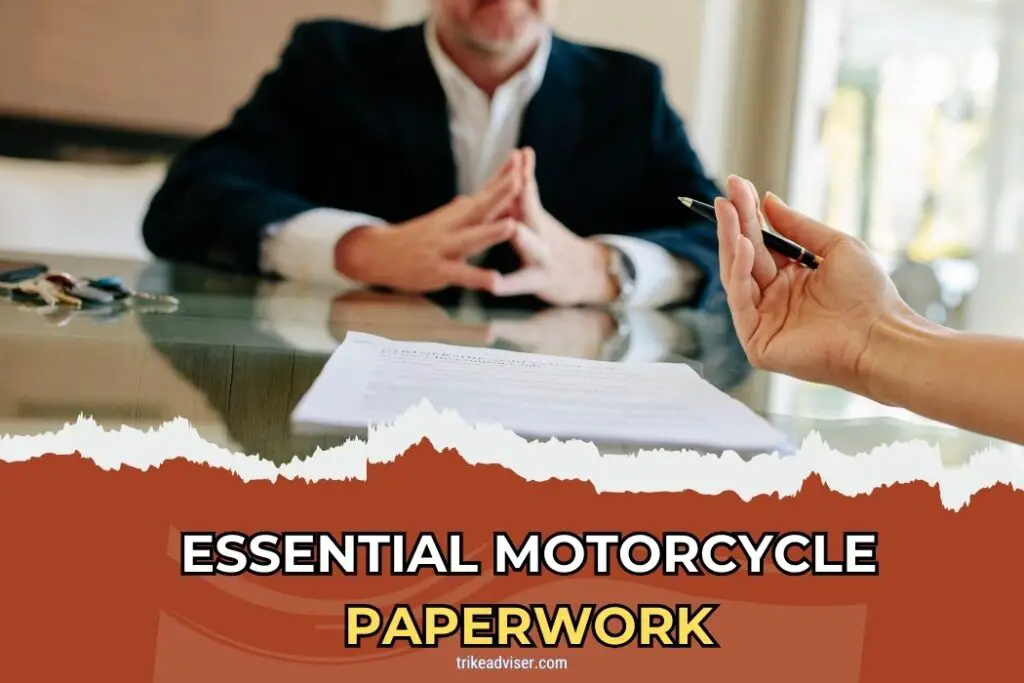Were you thinking of selling your motorcycle? Easy, right? Just post an ad and wait. But hold on. Have you ever tried to sell a bike only to discover that some crucial documentation is missing?
Isn’t it irritating? Picture yourself poised to close the sale, but you are unable to do it. Why? Missing documents. It’s not just about handing over the keys.
There’s a list of paperwork you need before you can say goodbye to your ride. No paperwork, no sale. It’s that straightforward. Avoid last-minute scrambles.
Know what documents are essential and why. Stay prepared. Keep reading to ensure you have everything sorted.
This isn’t just paperwork; it’s peace of mind. Ready to learn what these five essential documents are?
5 Essential Motorcycle Paperwork You NEED Before Selling
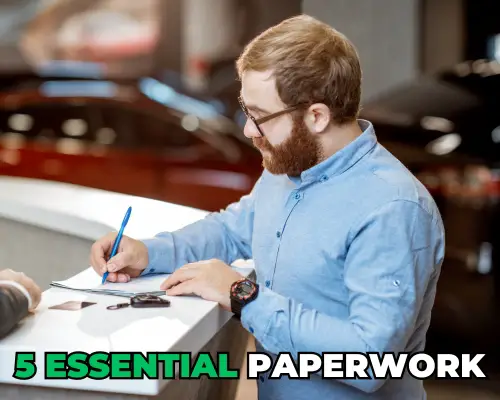
Title Transfer
The title isn’t just a document; it’s the proof of your bike’s lineage. Before you hand over the keys, make sure the title is properly filled out. This means every T crossed, every I dotted, and most importantly, signed over to the new owner.
Think of it as the official baton pass in the race to sell your motorcycle. Without this, the sale isn’t just stalled—it’s legally void.
Manufacturer’s Statement of Origin (MSO)
Next up, is the Manufacturer’s Statement of Origin, or MSO. This isn’t just any paper. It tells the story of your motorcycle from the factory floor to your garage.
Essential for registering a new bike, the MSO confirms your motorcycle’s identity down to the very last bolt. No MSO? No proof of origin. No sale.
Insurance Documentation
Now, let’s talk about insurance. In states like Montana, this document is more than a formality—it’s a shield.
Proof of insurance safeguards not just you, but also the buyer, and yes, that random pedestrian. It’s mandatory, critical, and frankly, a gesture of good faith. Selling without it? That’s like riding without a helmet.
V5C Logbook
Across the pond in the UK, the V5C logbook reigns. This isn’t just bureaucracy—it’s the biography of your bike.
Recording the keeper of the vehicle, this logbook is a must for legally transferring ownership. Think of it as the passport for your motorcycle’s new journey. No V5C? No transfer. It’s that simple.
Bill of Sale
Finally, the Bill of Sale. This isn’t just a receipt. It’s the narrative of your motorcycle’s valuation, featuring the sale price, date, and crucially, signatures from both parties.
It’s your fiscal handshake—a confirmation of the deal. Forget this, and your sale might just become an expensive gift. Always include it; always double-check it.
Set Perfect Prices – Win Customers & Profits
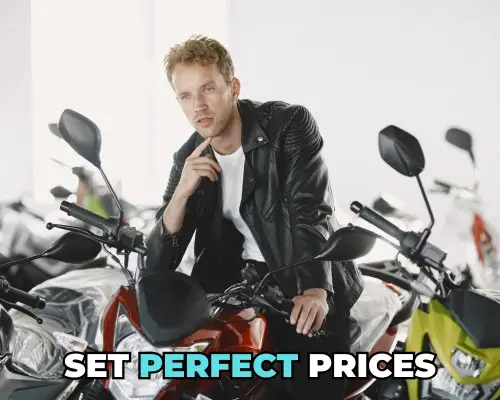
Pricing your motorcycle isn’t just about numbers; it’s about understanding the heart of the market and connecting with it just as you would connect with your bike on a long ride. Let’s delve deeper into how to achieve this with expert precision.
Market Research: How to Price Your Motorcycle Competitively
- Understand Market Conditions: Just like checking the weather before a ride, market research helps you anticipate what to expect.
Look at the sale trends over the past few months. For instance, did you know that motorcycle sales tend to increase as the weather improves? Timing your sale can fetch a higher price.
- Know Your Competition: It’s like scouting the route before a race. Analyze at least 10-15 listings for motorcycles similar to yours.
Note their condition, pricing, and how long they’ve been listed. This data helps you position your bike as the best option.
- Assess Your Bike’s Unique Selling Points: Has your bike been part of any noteworthy journeys or events?
This isn’t just about features, it’s about the stories and emotions tied to your motorcycle. A bike with a story often sells better.
Know the Value
- Condition Matters: Picture this: two identical bikes, one meticulously maintained, the other not as much.
Which would you choose? Always highlight the care you’ve given your bike, perhaps through a detailed log of maintenance and upgrades. This transparency builds trust and can increase the perceived value.
- Mileage Counts: Lower mileage often translates to a higher asking price. For example, a bike with 10,000 miles can be priced 10-20% higher than one with 30,000 miles, assuming similar conditions.
- Modifications: Be clear about any modifications. For instance, a performance exhaust might add up to 5% to your bike’s value if it’s a sought-after brand.
Set a Realistic Price
- Base it on Research: Think of pricing like setting your pace in a race—it should be strategic. According to a 2021 market analysis, bikes priced within 5% of the market average sold 50% quicker than those priced outside this margin.
- Be Competitive: Imagine you’re lining up your bike next to others. A price of just 2-3% lower can generate more interest, leading to quicker sales without significant loss of value.
Be Prepared to Negotiate
- Anticipate Questions: Know your bike’s history as well as you know your favorite route. Be prepared to discuss any past repairs or issues—it shows honesty and preparedness.
- Stay Cool: Negotiations can be as tense as navigating a tight curve. Keep calm, respond thoughtfully, and never let emotions dictate the deal.
- Be Ready with Facts: Arm yourself with knowledge. For instance, if asked about your pricing, you could explain that bikes with similar specs and conditions have sold for a similar price in recent weeks.
Use Questions to Your Advantage
- Engage the Buyer: Ask about their riding experiences to gauge their needs. This can guide how you highlight features of your bike that meet those needs.
- Build Rapport: Just like a shared ride creates bonds, so does a good conversation. Making the buyer feel understood can tilt the negotiations in your favor.
Be Flexible
- Know Your Limits: Set a clear lowest acceptable price in your mind, akin to knowing your bike’s fuel range.
- Make Concessions: Sometimes, offering a small concession, like including a bike cover or paying for the first service, can seal the deal.
Consider the Total Cost
- Inform the Buyer: Just as you would prepare for additional fuel stops on a long trip, help the buyer consider all costs associated with buying your bike.
- Factor These Into Negotiations: This clarity can prevent last-minute haggling and ensure a smooth transaction.
Walk Away If Necessary
- Stand Firm: Recognize when a deal isn’t right, much like knowing when a route is too risky to continue. Waiting for a better opportunity is sometimes the best course of action.
The sale of your motorcycle may be made profitable and pleasurable by careful planning and developing a real connection with each possible buyer. Like any well-planned journey, it may be fulfilling and unforgettable.
Legal and Administrative Considerations
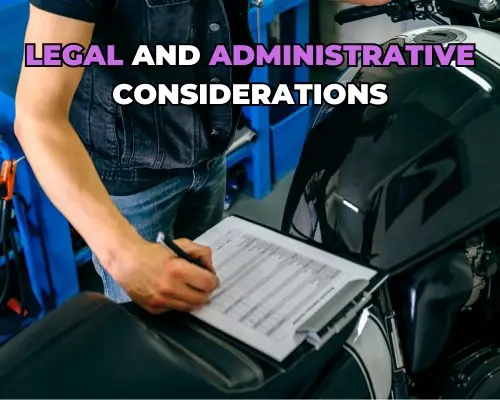
Navigating the legal landscape when selling your motorcycle can be as critical and nuanced as planning a cross-country tour.
Here’s a deeper dive into staying on the right side of the law and making sure your sale goes smoothly, without unexpected detours.
State-Specific Requirements: Understanding Local Laws for Motorcycle Sales
Local Laws Matter: Each state has its own rules, like unique road signs on different highways. For instance, in California, emissions standards are stringent, and selling a non-compliant motorcycle is like trying to pass a smog-heavy truck on a steep incline—risky and potentially costly.
Essential Documentation: Documents are your proof of ownership, just as a map is proof of your route. Make that all relevant information is appropriately reflected in your title, registration, and bill of sale and that they comply with state regulations.
It’s similar to making sure you’re traveling correctly before you start your engine by looking at your GPS.
License Requirements: Different states, different licenses. It’s akin to needing different gear for various weather conditions.
For instance, in Nebraska, selling motorcycles legally requires a certain motorcycle license; be sure you have all you need to comply with these legal requirements.
Steer Clear of Common Pitfalls: Avoid These Legal Errors When Selling Your Motorcycle
Upkeep and Examination: Sell a bike that isn’t in good condition, just as you wouldn’t embark on a lengthy ride with tires that are worn out.
Document your maintenance meticulously—this transparency not only builds trust but also justifies your asking price and wards off legal issues related to condition disputes.
Adhering to Regulations: Be transparent about your bike’s compliance with local laws, especially regarding emissions and safety standards.
Selling a bike that flouts local laws is not only unethical but could also land you in a legal pothole.
Security Measures: Protect your bike’s paperwork as securely as you would your bike itself. Any missing or falsified documents can cause as much trouble as a broken headlight on a night ride.
Additional Legal Tips:
Insurance Transfers: Make sure the new owner understands that they need to secure their insurance. It’s like making sure they have the right safety gear before they take the bike out for a spin.
Fair Negotiation Tactics: Approach negotiations as you would a challenging ride: prepared and alert. Misrepresentations can lead to crashes—legal ones. Be honest about what your bike offers and its past.
Dealership Legalities: For dealership owners, complying with state-specific requirements is as essential as having the right tools for a tune-up.
This includes maintaining a permanent facility, just as you would a dedicated workspace for your repairs.
Navigating through these legal checkpoints ensures a clear road to sale completion, much like a well-mapped ride.
By equipping yourself with the right knowledge and ensuring all documents are in order, you’re not just selling a bike; you’re ensuring a smooth and lawful transition to its new owner, leaving you free to plan your next adventure with peace of mind.
Meeting Potential Buyers
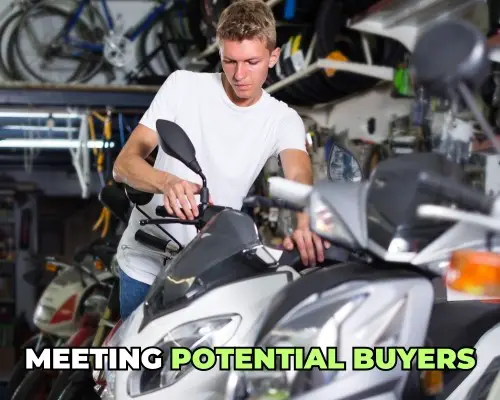
Engaging with potential buyers isn’t just transactional—it’s about forming a connection that not only sells your motorcycle but also leaves a lasting good impression.
Here’s how to conduct this process with the care and detail of a seasoned rider checking their gear before a long journey.
Safety First: Conducting Safe and Effective Test Rides
Ensuring safety during test rides is like preparing for a group tour—everyone’s security is your priority.
- Gear Up: Stress the necessity of safety gear. Just as you wouldn’t skip wearing your helmet on a ride, don’t allow test rides without the proper attire. This sets a professional tone and demonstrates your commitment to safety.
- Bike Readiness: Check the motorcycle as meticulously as a pilot would check their plane before flight. Ensure every part is in prime condition—from brakes to indicators. This not only prevents potential accidents but also reassures the buyer that you care for the bike.
- Feature Run-through: Remember, not everyone will be familiar with your specific model. Provide a thorough walkthrough of the motorcycle’s features and handling quirks. It’s like sharing insider tips with a fellow rider—it builds trust and appreciation.
- Guided Experience: Accompany the buyer on the test ride, perhaps following in a vehicle or on another bike. It’s an opportunity to demonstrate the bike’s capabilities and to show you are open and transparent.
- Post-Ride Inspection: Conduct a joint inspection after the ride. This can prevent any disputes about the condition of the bike pre- and post-ride, much like reviewing route maps after a group ride to ensure everyone agrees on the path taken.
Communication Skills: How to Effectively Communicate with Buyers
Communicating effectively with buyers involves clarity, honesty, and patience—qualities that define great leaders and trustworthy sellers.
- Honesty is the Best Policy: Be as open about your motorcycle’s history as you would be about your riding experiences. If it survived a crash, explain what happened and how it was fixed. Transparency builds trust.
- Address Concerns: Listen actively. Just as you would listen to the engine sounds for potential issues, listen to the buyer’s concerns. Addressing these effectively can often be the key to closing the sale.
- Balanced Communication: Be assertive yet respectful. It’s like negotiating a tricky section of the road—you need to be firm but cautious.
- Value Defense: Know your bike’s worth. Have comparable sales data or valuation reports handy, much like carrying the right documents for a border crossing. This shows you’re informed and serious about your pricing.
- Stay Professional and Cordial: Maintain professionalism like a tour guide who’s responsible for the enjoyment of the group. Keep the interaction pleasant and productive, ensuring the buyer leaves with a positive impression, regardless of whether a sale is made.
Meeting with potential buyers is as much about displaying your motorcycle’s value as it is about showcasing your respect for the buying process.
By placing a strong emphasis on security, openness, and polite communication, you foster an atmosphere where trust may grow and business dealings can go easily.
The key to a successful ride, as with any well-planned journey, is preparation and flexibility to meet the demands of the road, or in this case, the buyer.
As an Amazon Associate, I earn from qualifying purchases, at no additional cost to you. Read Our Affiliate Disclosure.

